|
 |
 Автор: Williams Автор: Williams
 Дата: 7 февраля 2018 Дата: 7 февраля 2018
 Просмотров: 1 440 Просмотров: 1 440 |
| |
Ensoft Group 2016.10.12
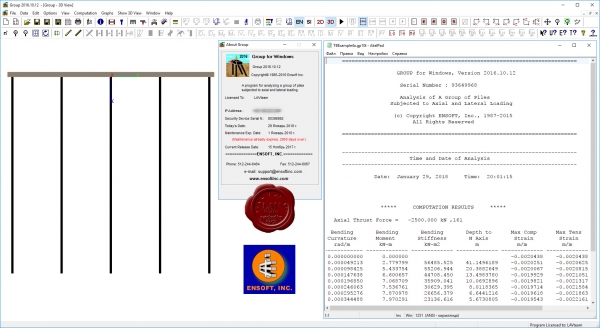
GROUP has been well accepted as an useful design tool for analyzing the behavior of piles in a group subjected to both axial and lateral loadings. The program was developed to compute the distribution of loads (vertical, lateral, and overturning moment in up to three orthogonal axes) applied from any multiple locations in the pile cap to piles arranged in a group. The piles may be installed vertically or on a batter and their heads may be fixed, pinned, or elastically restrained by the pile cap. The pile cap may settle, translate, and/or rotate and is assumed to act as a rigid body.
The program will generate internally the nonlinear response of the soil, in the form of t-z and q-w curves for axial loading, in the form of p-y curves for lateral loading and in the form of t-r curves for torsional loading. A solution requires iteration to accommodate the nonlinear response of each pile in the group model. Program GROUP solves the nonlinear response of each pile under combined loadings and assures compatibility of geometry and equilibrium of forces between the applied external loads and the reactions of each pile head.
The p-y, t-z, q-w and t-r curves may be generated internally, employing recommendations in technical literature, or may be entered manually by the user. The pile-head forces and movements are introduced into equations that yield the behavior of the pile group in a global coordinate system. The program can internally compute the deflection, bending moment, shear, and soil resistance as a function of depth for each pile.
For closely-spaced piles, the pile-soil-pile interaction can be taken into account by introducing reduction factors for the p-y curves used for each single pile. As an option, the user can ask the program to generate internally some suggestions for p-multipliers to automatically reduce the soil resistance. GROUP is able to generate or lets users specify p-y reduction factors for two orthogonal axes.
The program allows the user to select computations of the required unit side friction at the top and bottom of each soil layer along with a unit tip resistance. The program employs commonly-accepted equations to compute internally the estimated unit side friction and unit tip resistance based on the soil properties that are specified by the user for each soil layer.
Users can also input external nonlinear curves of axial load versus settlement for each pile in the group. Those external curves can be obtained by the user based on load tests or using the Ensoft programs APILE and/or SHAFT.
GROUP introduces several enhancements: Use of multiple load cases representing concentrated loads at the pile cap and/or distributed lateral load at the piles; Concentrated loads at the pile cap may be defined at any position; Distributed lateral loads at the piles can be defined by local or global axes; Load combinations can be specified by the user and are set by load factors applied at the defined load cases; Maximum and mini-mum envelopes may be computed for both load cases and load combinations; GROUP v8 can provide flexibility and stiffness matrices (in 2D or 3D models) for different levels of loading. |
| |
 Читать статью дальше (комментариев - 12)
Читать статью дальше (комментариев - 12)
| |
|
 |
 Автор: Williams Автор: Williams
 Дата: 6 февраля 2018 Дата: 6 февраля 2018
 Просмотров: 1 248 Просмотров: 1 248 |
| |
Ensoft LPile 2018.10.02 repack
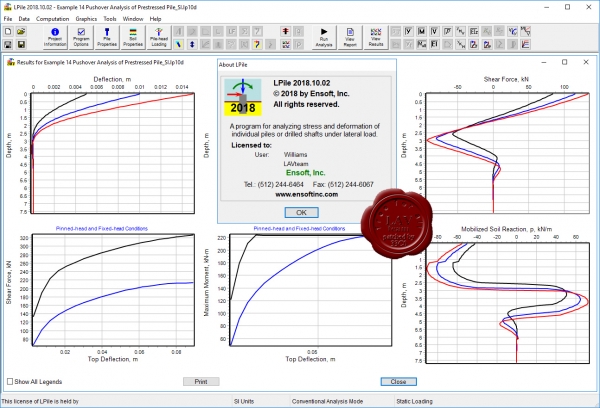
LPILE is a special-purpose program based on rational procedures for analyzing a pile under lateral loading using the p-y method. LPILE solves the differential equation for a beam-column using nonlinear lateral load-transfer (p-y) curves. The program computes deflection, bending moment, shear force and soil response over the length of the pile.
As an option, components of the stiffness matrix at the pile head may be computed internally by LPILE so users can incorporate basic soil-structure interaction in their super-structure analyses. Another option from LPILE provides graphs of pile-head deflections for various pile lengths, to help users with optimum pile penetrations (for lateral response).
Nonlinear lateral load-transfer from the foundation to the soil is modeled using p-y curves generated internally using published recommendations for various types of soils. Special procedures are programmed for computing p-y curves for layered soils and for rocks. Alternatively, the user can enter manually any other externally generated ip-y curves.
Five types of pile-head boundary conditions may be selected, and the structural properties of the pile can vary as a function of depth. LPILE has analytical features to compute the nonlinear moment-curvature relationships and nominal moment capacity of a pile’s section based on specified pile dimensions and nonlinear material properties. Optionally, the user may enter nonlinear moment-curvature relationships to be used in place of the internally-generated values. LPILE provides several design recommendations for rebar arrangements in drilled shafts. |
| |
 Читать статью дальше (комментариев - 1)
Читать статью дальше (комментариев - 1)
| |
|
 |
 Автор: Williams Автор: Williams
 Дата: 4 февраля 2018 Дата: 4 февраля 2018
 Просмотров: 1 412 Просмотров: 1 412 |
| |
Golden Software Grapher v13.0.629 x32+x64
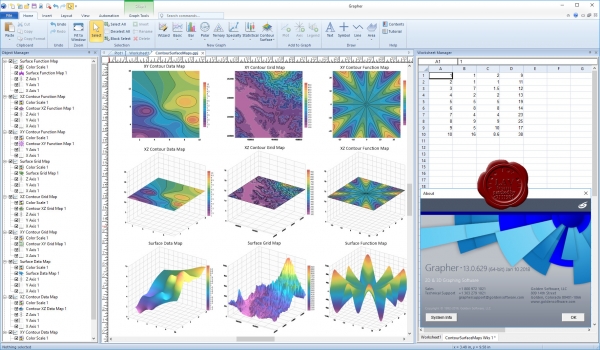
Golden Software Grapher - мощный и одновременно простой в использовании графический пакет, позволяющий быстро создавать высококачественные графики. Grapher позволяет строить более 54 видов двухмерных и трёхмерных графиков. Кроме того, вы можете настраивать любую часть графика или создавать свои собственные графики, наилучшим образом описывающие ваши данные. Программа содержит 4 типа двухмерных графиков: линейные, столбчатые, полярные и специальные. Все эти типы графиков доступны и в трёхмерном исполнении. Если вам требуется отразить дополнительную переменную, вы можете воспользоваться графиками 3D XYZ, контурными картами или картами поверхности.
Спецификации Grapher:
- Разноцветные столбчатые и пузырьковые диаграммы.
- Градиентная заливка для всех объектов.
- На графиках 3D XYZ можно добавлять вертикальные линии сетки.
- Настройка любой части графика под вашу уникальную ситуацию.
- Простое создание своих собственных пользовательских графиков с помощью мастера.
- Создание шаблонов и их сохранение для использования на других графиках.
- Разбиение длинных подписей к осям.
- Автоматизация процесса постороения графиков.
- Запись процессов графика внутри сценария.
- Экспортирование графиков для использования в презентации и публикации в одном из многочисленных форматов, в том числе векторных PDF, EMF, EPS и т.д.
|
| |
 Читать статью дальше (комментариев - 12)
Читать статью дальше (комментариев - 12)
| |
|
 |
 Автор: Williams Автор: Williams
 Дата: 3 февраля 2018 Дата: 3 февраля 2018
 Просмотров: 1 573 Просмотров: 1 573 |
| |
Ensoft LPile 2018.10.02

LPILE is a special-purpose program based on rational procedures for analyzing a pile under lateral loading using the p-y method. LPILE solves the differential equation for a beam-column using nonlinear lateral load-transfer (p-y) curves. The program computes deflection, bending moment, shear force and soil response over the length of the pile.
As an option, components of the stiffness matrix at the pile head may be computed internally by LPILE so users can incorporate basic soil-structure interaction in their super-structure analyses. Another option from LPILE provides graphs of pile-head deflections for various pile lengths, to help users with optimum pile penetrations (for lateral response).
Nonlinear lateral load-transfer from the foundation to the soil is modeled using p-y curves generated internally using published recommendations for various types of soils. Special procedures are programmed for computing p-y curves for layered soils and for rocks. Alternatively, the user can enter manually any other externally generated ip-y curves.
Five types of pile-head boundary conditions may be selected, and the structural properties of the pile can vary as a function of depth. LPILE has analytical features to compute the nonlinear moment-curvature relationships and nominal moment capacity of a pile’s section based on specified pile dimensions and nonlinear material properties. Optionally, the user may enter nonlinear moment-curvature relationships to be used in place of the internally-generated values. LPILE provides several design recommendations for rebar arrangements in drilled shafts. |
| |
 Читать статью дальше (комментариев - 24)
Читать статью дальше (комментариев - 24)
| |
|
 |
 Автор: Williams Автор: Williams
 Дата: 2 февраля 2018 Дата: 2 февраля 2018
 Просмотров: 1 054 Просмотров: 1 054 |
| |
Intetech Electronic Corrosion Engineer v5.4.0
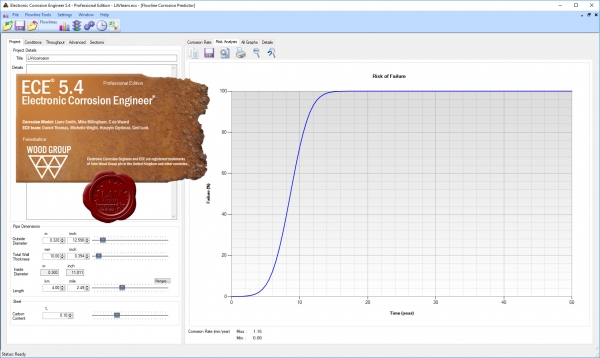
Intetech Electronic Corrosion Engineer is a tool for the quantitative estimation of corrosion rates and the selection of materials for gas and oil production systems and processing facilities. The software is available as a stand-alone PC version for single users, or a server-based system for multiple users. Significant improvements range from technical modelling developments, new functionality, updated information on materials, wider choice of graphs and improved reporting and printing capabilities. The software is in a new-look format which is compatible with latest operating systems.
Intetech Electronic Corrosion Engineer tools:
- Corrosion rate predictionfor carbon steel in sweet or sour conditions that consider different options for corrosion control.
- Risk prediction tools that evaluate the risk of carbon steel failure.
- Corrosion-resistant alloy (CRA) evaluators that select the most suitable CRA for specified environmental conditions, and automatically take into account the risks of corrosion, pitting and stress-corrosion cracking.
- Life-cycle cost calculators that evaluate the economics of carbon steel and CRA options on the basis of Net Present value so that material cost comparisons can be provided.
- A database of alloy tubing and pipe manufacturers.
|
| |
 Читать статью дальше (комментариев - 16)
Читать статью дальше (комментариев - 16)
| |
|
 |
 Автор: Williams Автор: Williams
 Дата: 1 февраля 2018 Дата: 1 февраля 2018
 Просмотров: 3 036 Просмотров: 3 036 |
| |
Integrated Engineering Software Building Suite 2018
ShapeBuilder v9.00.0009
VisualConnect v3.00.0001
VisualAnalysis v17.00.0012
VisualFoundation v8.00.0004
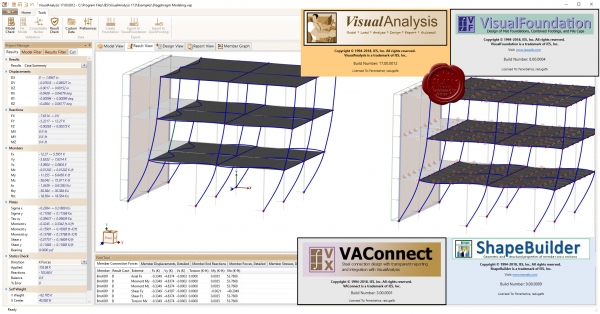
IES, Inc. creates high quality structural design software for engineering and related professionals. Your solution for general analysis, frames, trusses, shear wall systems, foundations, retaining walls, floor systems and more in steel, wood, concrete, aluminum, cold-formed, and masonry.
ShapeBuilder is a section properties calculator, stress analysis, shape database customization. Get torsion properties, cracked section properties, concrete section capacities and interaction diagrams. Integrates with VisualAnalysis. More info.
VAConnect is a set of connection-design utilities that integrates with VisualAnalysis Design level or higher. Save the time and hassle of copying loads and geometry from one program to another. Face it, checking many load combinations is a pain, but VAConnect does exactly what is needed using all the loads from VisualAnalysis, while grouping similar connections for consistent, organized design. The tools also run stand-alone for the situations where you just have a quick check to make or a question to answer. Get back to any design in seconds to update a value or print a report. To run the stand-alone tools, you must purchase the product outright or get it as part of the IES Building Suite or IES Total Suite. With IES Transparent Reporting you get either summary reports or details that look and feel like you wrote them out by hand with sketches, equations, code references, and a clear, logical flow. These tools are the opposite of black-box and blind-trust. More info
Why use VisualAnalysis? You have choices in the marketplace for general-purpose FEA tools but VisualAnalysis shines in a number of areas:
- Excellent for everyday projects.
- Great for unusual projects, and large, complicated models.
- Three feature and price levels available: Compare Levels.
- Building-code support is optional, use it for mechanical applications too.
- Extremely versatile: model just about anything!
- Reporting is extremely powerful and very flexible (save your own styles).
- So easy to use, most customers are productive within hours of installing.
- Over 3000 companies use IES tools: one part-time support person at IES!
- BIM support: VARevitLink provides two-way integration with Autodesk Revit Structure.
Why use VisualFoundation? You have choices in the marketplace, for mat footings -even among IES tools! VisualFoundation shines in a number of areas:
- Dedicated to foundations, so easier to use than VisualAnalysis for this task.
- Automated modeling - the FEA model is built and refined automatically.
- Incorporate the effects of walls and beams in the slab.
- Over 2500 companies use IES tools: one part-time support person at IES!
Major Benefits and Abilities:
- Mat foundation analysis and design.
- Complex mat boundaries, including circular and polygonal templates.
- Generate copies of modeling elements using rectangular or circular patterns.
- Multiple mat thicknesses or soil properties.
- Holes in mats.
- Combined footings.
- Wall footings.
- Walls, grade beams, columns and pile supports.
- Unlimited model size.
- Support for codes: IBC, ASCE 7, ACI 318.
- Automated FEA meshing and soil-spring supports.
- Sophisticated thick-plate finite element formulation.
- Import & Export DXF files.
- Import & Export with VisualAnalysis.
- Improved usability: easy graphics and toolbar commands.
|
| |
 Читать статью дальше (комментариев - 18)
Читать статью дальше (комментариев - 18)
| |
|
 |
| ПОИСК ПО САЙТУ |
 |
|
 |
|